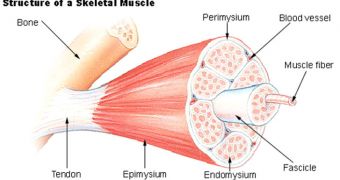Muscle deterioration is a process that can be found in people who suffer from conditions such as Duchenne muscular dystrophy (DMD) or who have been confined to bed rest in old age, and now find it impossible to recover their muscle mass. Now, a new type of cells is used as a therapeutic target.
Researchers with the US National Institutes of Health (NIH) National Institute of Arthritis and Musculoskeletal and Skin Diseases (NIAMS) conducted the investigation, which identified a specialized population of cells called satellite cells as critical players in these conditions.
What researchers are looking to accomplish is find a way of using these cells to cure conditions in which muscles deteriorate, and can no longer regain their mobility or flexibility. Details of the new work appear in the latest issue of the medical journal Genes & Development.
People suffering from DMD, for example, tend to succumb to their disease in early adulthood, whereas they manage to endure their affliction well throughout childhood and their teen years. Why this happens remained a mystery for experts for a very long time.
In the new investigation, satellite cells were discovered to play a role in underlying the muscles' ability to heal themselves, or to increase their mass as soon as this is asked of them, PhysOrg reports.
This cell populations also plays a critical role in the development of skeletal muscles in embryos and fetuses, while they are still in their mothers' wombs. After a certain age, satellite cells become inactive, which means that they enter some sort of stand-by mode.
Whenever they are needed again, such as for example to repair a damage incurred to muscles, or to build up mass after strenuous exercises are done regularly, they reactivate and go on about their business. But this no longer happens in DMD patients, or in seniors who are confined to bed.
The muscular repair mechanism does have its limits, says the lead author of the study, and it was researchers' job to figure out what those limits were. The work was led by NIAMS Laboratory of Muscle Stem Cells and Gene Regulation senior investigator Vittorio Sartorelli, MD.
He explains that DMD patients whose satellite cells enter hibernation die because this process takes place in early adulthood. While they are kids and teens, their satellite cells are perfectly capable of keeping up with muscle deterioration by constantly repairing damaged cells.
“That is why people can survive until they are 20 years old without much of a problem, but, at a certain point, satellite cells stop proliferating. That is the point at which the patient will start developing weakness and problems that will ultimately lead to death,” the team leader says.
In the future, treatments to boost satellite cells proliferation rates could lead to increased survival rates for DMD patients, as well as to a higher quality of life for seniors that have just gotten out of a long bed rest.

 14 DAY TRIAL //
14 DAY TRIAL //